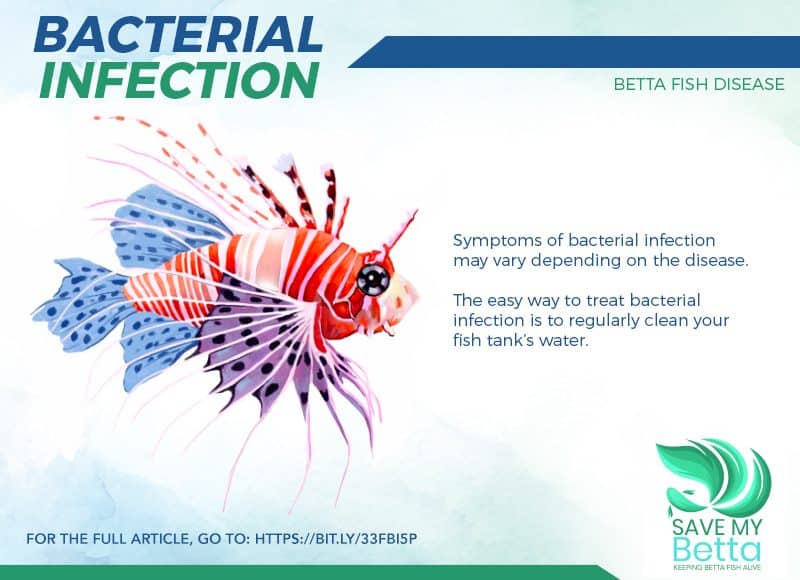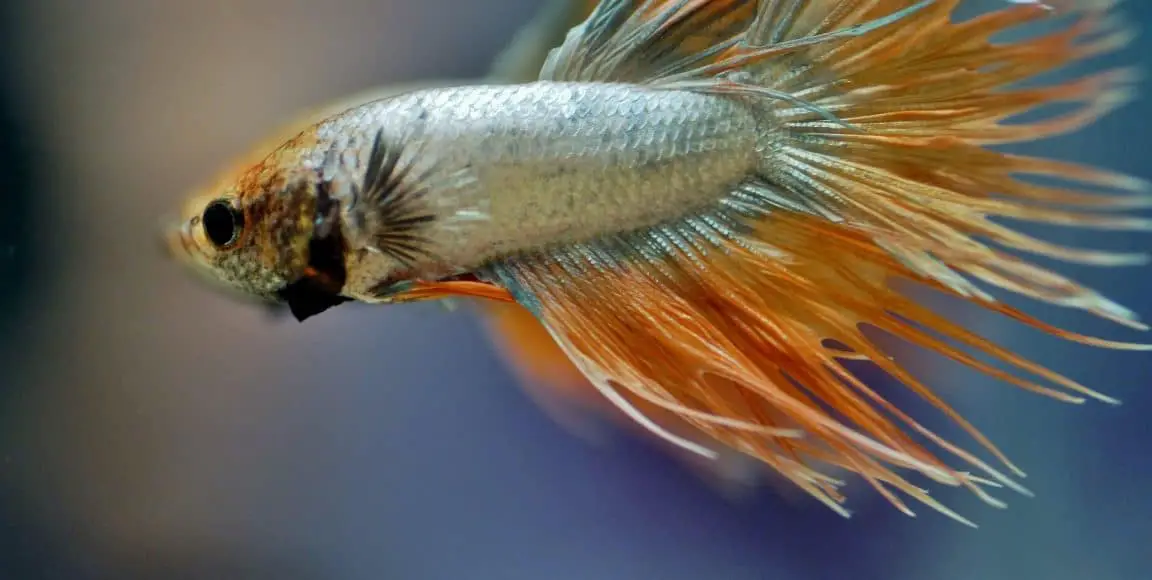Last Updated on October 6, 2020
Fish diseases that bacterial infection causes are such a pain in the head. There’s no easy way out in treating a bacterial infection on betta fishes. It costs time, money, and most of all, patience.
That’s why you need to tend your bettas as soon as possible before the grim reaper will take a visit to your fish tank. So how do we deal with a bacterial infection in betta fishes? That’s what we will tackle in this article.
Table of Contents
What is Betta Bacterial Infection?

A bacterial infection is a fish disease caused by bacterial buildup. Such examples are fin rot, dropsy, and more which we will tackle later on. Treating bacterial infections is a bit of a challenge since it mostly relies on using antibiotics which can lead to water anomalies.
That’s why you should treat betta bacterial infection with care so you won’t hurt your betta fish during the process. Sometimes, you may need to seek help from an expert to cure such bacterial infections on your betta fish.
Causes of Betta Bacterial Infection
The primary reason for aquarium bacteria buildup is poor aquarium maintenance. This includes dirty water that’s been sitting for weeks, unscoped fish stool, and lack of water conditioning.
This is why it is important to properly maintain your betta fish tank. You can’t just sit there and expect it to automatically clean itself. Keep in mind that having a pet fish isn’t the same as having four-legged pets.
You need to maintain your fish tank regularly to keep your bettas safe from bacterial infections and any kinds of fish diseases.
Symptoms of a Betta Fish with Bacterial Infection
It’s tricky to spot a betta fish that has caught a bacterial infection. But here are a few common signs that you should look for.
Erratic swimming
Betta fishes will be uneasy when they catch a disease caused by a bacterial infection. They may experience pain that causes them to behave abnormally, and this includes erratic swimming without a clear pattern.
You will usually see them randomly swimming in every angle as if an invisible bogey fish is chasing them inside the tank. It may be funny to look at them this way, but they are trying to endure the pain they feel.
They lose their appetite
Just like humans, fishes also lose their appetite when they have a disease caused by a bacterial infection. This also applies not only to bacterial infection but also many kinds of fish diseases.
Most of the time, bettas will just stay put in a corner and ignore the foods you give them. If left untreated, it will lead to starvation and even worse, death. There will be instances where they’ll try to eat but eventually ignores the food after a few seconds.
Body changes
Betta fishes are colorful and vibrant creatures. Not until they have a bacterial infection that causes them to lose their colors. A bacterial infection can weaken their immune system, which results in abnormal body changes.
This includes their colors to fade, fins and tails wearing off, eyes popping out, and among others. The reason behind this is that the bacteria is slowly taking over their body, which can lead to their death.
Betta Bacterial Infection Diseases

Now that you know what a betta bacterial infection is all about and its symptoms, let’s look at what these bacterial infections are.
Fin rot
Fin rot is the most common bacterial disease among betta fishes. As the name suggests, it’s a disease where the fin (and even the tail) of your betta fish will rot.
The rotting process happens gradually until it fully takes over the betta fish’s body. Fin rot is a fatal yet curable disease. But you have to treat it as soon as possible before it spreads to other fishes inside the tank.
Dropsy
Dropsy is a bacterial infection in the betta fish’s kidney. Its symptoms include bloated bodies and protruding scales. Dropsy can make your betta fish look pregnant.
So it is important to determine if your betta really has the disease or they are just pregnant all along. Dropsy is a rare occurrence and only infects betta fishes with a weak immune system. We often see dropsy as a secondary bacterial infection to the main disease.
Swim bladder disease
The swim bladder disease affects your betta’s ability to swim. A bacterial infection that is accumulating in the water because of poor fish tank maintenance causes this.
Betta fishes that have this disease are usually swimming erratically (as mentioned earlier). You will notice them struggling to keep their balance, swimming upside down, and having trouble reaching the surface of the fish tank.
Treating Betta Bacterial Infection

Treating bacterial infection on betta fishes is as easy as cleaning your fish tank. But before anything else, you must make a quarantine tank to keep them away from other fishes and spread their disease.
Creating a quarantine tank is like making an ordinary tank only with a few adjustments. This includes putting medication (more on that later) and adjusting aquarium parameters such as temperature or pH levels to an optimal value.
Related: Betta Fish Popeye Treatment: How to Cure Your Fish of this Disease?
Changing your main aquarium tank
After making the quarantine tank, it’s time to get those cleaning materials (and wallet) ready and keep these considerations in mind.
Remove “suspect” materials
The things you put inside the tank may lead to fish tank bacteria buildup. This may be the plants, the substrate, or even the decorative ornaments.
Do not overcrowd your fish tank with too many objects. This will make your betta fish become stressed, making them the perfect bait for bacterial diseases. And if ever you want to push your creative mind to its limits, consider the next tip below.
You may need a bigger tank
If you really want to unleash your inner artist when decorating your fish tank, then consider buying a bigger one. You can put many live plants and decorations as much as you want with a bigger fish tank.
It is also spacious enough giving your betta fish more room to freely swim and play around. Just don’t overdo the decorations and it should be fine. But, the bigger the tanks also means twice the effort in cleaning too.
Live plants are the way to go
If you have been decorating your fish tank with plastic plants, it’s time to get rid of them in favor of live plants. Live plants act as a natural filter that removes toxins and harmful chemicals to keep the water clean.
Keep in mind that betta fishes love to nibble on plants. And this is why live plants are the ideal choice for that because it is natural and contains nutrients compared to plastic plants made from chemicals that can hurt your betta fish.
But, maintaining will be a chore if you opt for live plants. They can grow over time and may turn your fish tank into a mini forest. That’s why it is important to trim them regularly.
The lesser the better
Having less not only applies when you are decorating your fish tank but also to the fishes you put on it as well. Betta fishes are aggressive and they love to have their own personal space instead of sharing with other fishes.
So it is important to keep their numbers low. Overcrowding your tank may stress out your betta fish. When stress takes over their body, their immune system can weaken making them susceptible diseases caused by bacterial infection.
Get rid of ammonia ASAP
Ammonia is a kind of waste released by freshwater fishes such as bettas. Ammonia can be bad for the water quality of your fish tank so it’s best to get rid of them as soon as you can.
Ammonia can also convert into nitrite if not prevented early on. This happens when bacteria that are living in the substrate, rocks, or the decorations are mixed with the ammonia.
Nitrite is just as toxic as ammonia. And that’s why it is better to do a complete overhaul of your main fish tank to ensure that you don’t leave a single spec of harmful chemicals, toxins, and bacteria.
Medication matters
We mentioned earlier that you should mix your quarantine tank with medication to help the betta during the healing process. Here are the best medications for the bacterial infection you can buy in pet stores.
Melafix Fish Bacterial Infection Treatment
API’s Melafix Fish Bacterial Infection Treatment is effective in curing any kind of fish disease caused by a bacterial infection. This medication contains natural tea tree extract that helps cure damaged fins, tails, and open wounds. It is suitable for both freshwater and saltwater fishes too.
Bettafix Bacterial Infection Treatment
API made this as well. As the name suggests, they specifically made this medication for betta fishes. Its function is the same as the medication above only with the exclusion of saltwater fishes. This means it is only compatible with freshwater fishes such as bettas.
Aquarium salt
Aquarium salt is the cheapest fish medication you can find. Don’t confuse it with table salt because doing so is a recipe for disaster. Aquarium salt is effective in improving your betta fish’s quality of life.
It promotes a healthy gill function to let your betta fish breathe easily. Other than that, it also has the same healing properties as Melafix and Bettafix.
An important reminder when using medication is to avoid overdoing it. Always read the instructions on the packaging to avoid accidents. Keep in mind that aquarium medication is from chemicals too, which can pose bad things to your betta fish.
You may need to adjust fish tank parameters to help the medication. More often than not, fish medication requires different aquarium temperatures and filter levels. So don’t forget to do that after pouring the medication into the water.
Related: How To Cure Betta Fish Ick The Right Way
The Monitoring Process
Now that we’re good with the treating process, it’s time to monitor the state of your betta fish. But don’t fret because you don’t have to let your eyes glued on the fish tank for 24 hours a day.
Better yet, set a specific day on the week if you will monitor the bettas. Do this for at least 10 minutes and see if there are changes with the symptoms. You can also jot down on your notes about its healing progress.
Write which vitamins work best for this bacterial disease, how many days before they get fully healed, and so on. Keeping a record of the process lets you easily manage your betta fishes just in case they can contract a bacterial disease the next time around.
Conclusion
A clean and well-maintained betta fish tank really pays off. It may be a chore to do so, but at least your betta fishes will develop and grow healthy.
Taking care of betta fishes may not be the same with four-legged pets, but at least it gives you an idea about the ins and outs of having an aquatic pet.
Don’t treat your betta fishes as a responsibility that you have to carry on for its lifespan. Because if you do, the enjoyment of having a pet fish may go away. Treat your bettas as a child that you will tend every day.
Give them foods that can contribute to their growth and development. Improve their shelter by decorating it with live plants where they can hide and chill.
These little things will make your betta fishes happy, and so are you.
